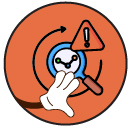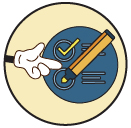The Americans with Disabilities Act (ADA) Title 2 ruling means public entities must have accessible online content.
This toolkit is designed to help you build an accessibility strategy, so you can meet requirements.

This toolkit has:
- An overall accessibility strategy.
- Specific tasks for different content types (website, video, documents, and learning).
- Tips for 3rd party tools, communicating with leadership, and training.
The tasks in this toolkit give you a head start on building project plans and strategies. They are not an exhaustive checklist to meet accessibility requirements for your specific organization. These are adapted from the Web Accessibility Framework.
The overall digital accessibility strategy
Most digital content can be grouped into one of these four categories:
- Website
- Learning Management System (LMS)
- Documents (PDFs, Word, Excel, etc.)
- Video
Breaking up the work by these content types helps make it more manageable, and it’s easier to find unique opportunities and easy wins.
The general strategy for each content type is:
- Identify what you have and your environment
- Put processes for prevention in place
- Test and fix existing content

Identify environment
Goal: Discover what you have and opportunities.
In this phase, you answer these questions:
- What content exists?
- How much is there?
- Who makes the content?
- What policies currently exist (if any)?
- What processes currently exist (if any)?
- What monetary, technological, time, and people resources currently exist?
- Is anything already working well that we could build on?

Put processes in place
Goal: Build processes that maintain your content’s accessibility.
During this phase, you’ll:
- Get leadership buy-in for policies (if needed)
- Define the ideal processes for creating and maintaining accessible content
- Start the training plan for those who are responsible for creating and maintaining content
- Start regular and consistent automated and manual testing

Fix existing content
Goal: Test existing content and fix accessibility issues.
This is the phase where you update existing content. In this phase, you’ll:
- Determine who is responsible for the work
- Set goals, starting with easy wins and opportunities
- Create a plan for escalating potential blocks and barriers
Find easy wins or ways to simplify
Goal: Find opportunities to build on.
This isn’t a step, but it is something you should always be on the lookout for.
As you go through each step, you’ll find people, technology, departments, processes, or bodies of work that you could focus your energy on to get the momentum going.
The hardest part to scaling accessibility efforts is getting people to change current (official or unofficial) processes. These easy wins or ways to simplify should help you get people on board, making it easier to scale.
Examples:
- A department that has the desire to do the work.
- An existing process that is working well.
- An existing project is working on updating content.
- Existing technology that aids in parts of the work.
- A tactic that gets people motivated to do the work.
Want a jump start?
Our accompanying webinar covers how to break up your accessibility efforts into more manageable pieces with real-life examples.
Start in the right direction quicker.
Our experts are here to help plan your ADA compliance strategy.






